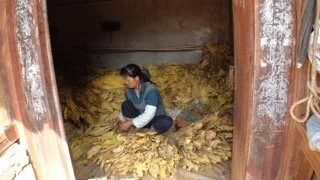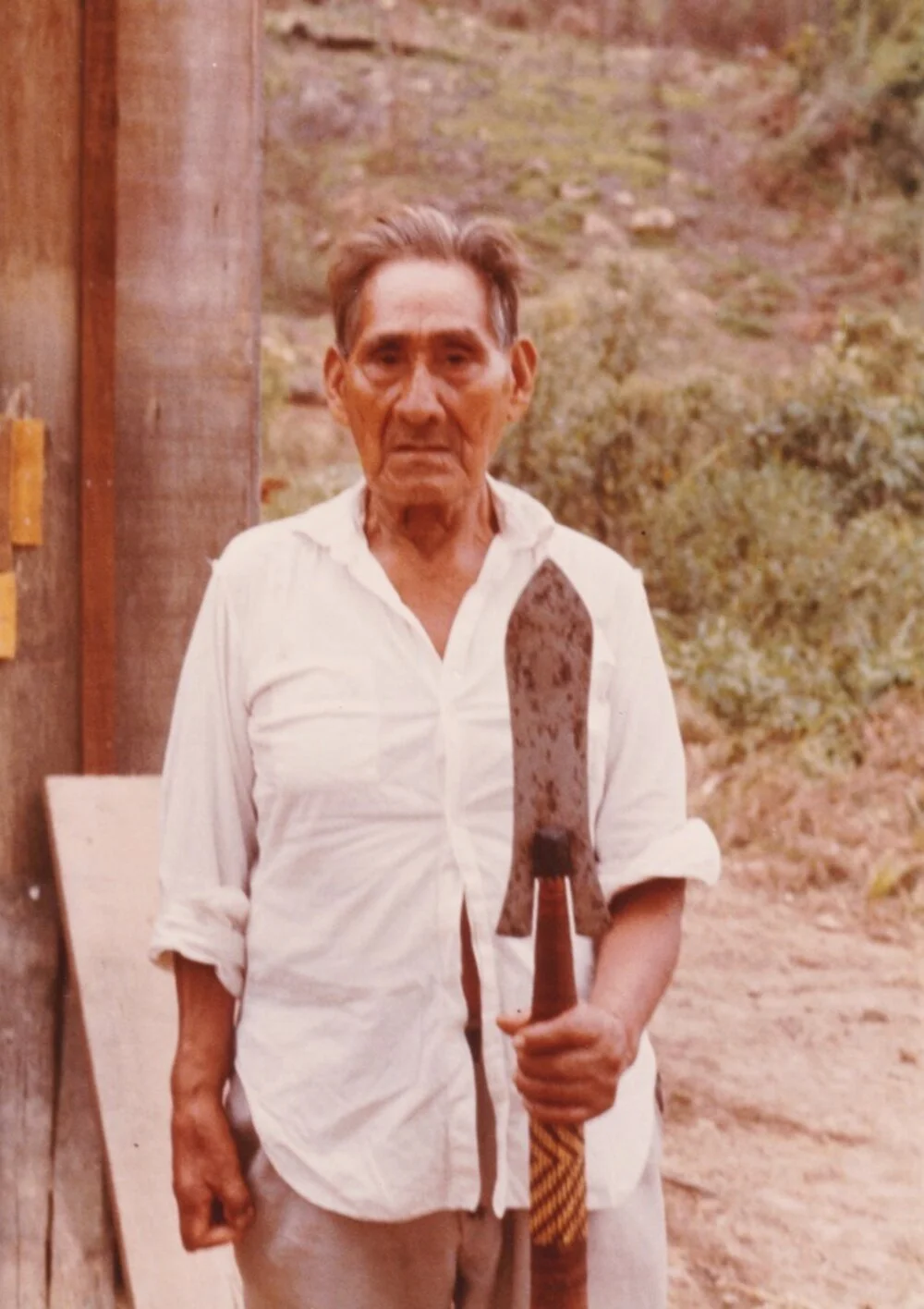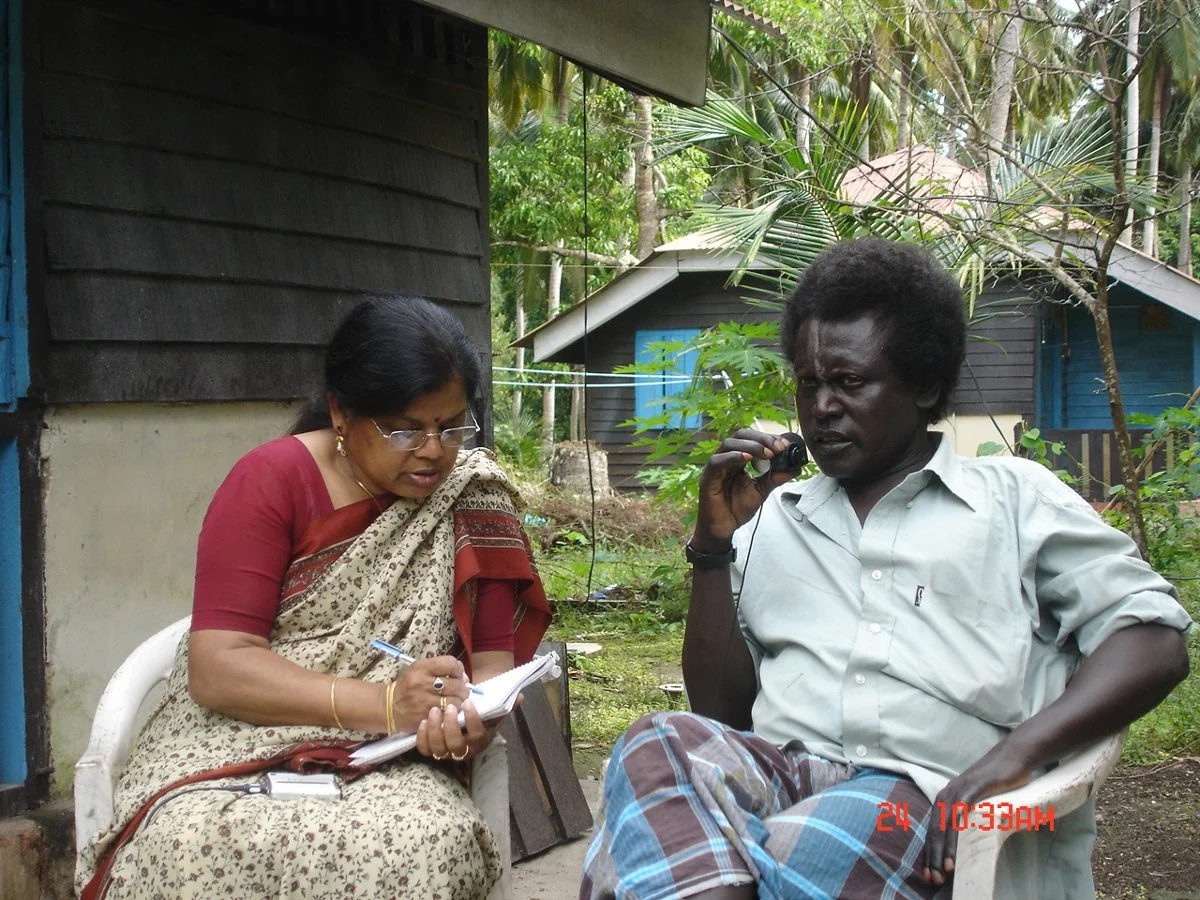STORIES
Ju|’hoan
It Takes Both Sides of the Digital Divide: The Ju|’hoan Transcription Group
by Megan Biesele
Kalahari Peoples Fund
Austin, Texas USA
Storyteller & Anthropologist (!U’u Dabe & Megan Biesele)
by Dahm Dabe for Kalahari People’s Fund
In June and July, 2006, in the remote Kalahari administrative town of Tsumkwe in northern Namibia, six young Ju/’hoan San trainees, trained in computer literacy and transcription of their only-recently-written language, were hard at work on donated laptops. With anthropologist Megan Biesele, they were transcribing and translating from digital soundfiles hundreds of hours of folktales, healing narratives, and other materials Megan had recorded as long ago as 1970. At one point in a detailed phenomenological description of the mechanisms of traveling on the “threads of the sky” to God’s village, which Ju/’hoan healers do in an altered state of consciousness, a trainee sighed, “If only /Kunta Boo (the raconteur on the old soundfile) were here to help explain all this to us so we could get it written down right!” At that moment, Biesele looked towards the doorway of the community library where she was working with her trainees. There stood old /Kunta himself, having trekked in from his far-off camp when he heard they were in town. It was the first time Biesele had seen him in years. Without further ado, he and his wife sat down by the computers in the midst of the young people and didn’t get up for two solid weeks except for breaks or to go to bed at night. They went through the soundfiles with the trainees word for word. Excitement erupted around this collaborative process which, along with transcriptions, began to generate many esoteric vocabulary words for the trainees to use in updating their dictionary. The result was over 200 pages of authoritative, annotated, richly nuanced, transcribed and translated Ju/’hoan material that answers many questions outsiders have had about the people’s famous, but mysterious, healing dance. When /Kunta and his wife left to go back to their village, one of the trainees was moved to read a speech he had written, which contained the words “We young people could never have done this work correctly without you, our elders.”
This 2006 field experience describes the program’s innovative workshop format for processing authoritative texts. It also signals the continuation of a community-based, contextualized, and critical language project that has been building for several decades and is still operating today in 2016. This project is called the Ju|’hoan Transcription Group (JTG) and it has provided the basis for the extensive archive of Ju|’hoan soundfiles and metadata provided to the Endangered Languages Archive (ELAR) in the course of two grants to Megan Biesele by the Endangered Languages Documentation Project (ELDP), a Field Trip Grant and a Major Documentation Project Grant.
The Ju|’hoan Transcription Group was established in 2002 as an outgrowth of the Nyae Nyae Village Schools Project (VSP) in Namibia, a mother-tongue school project co-founded by Megan Biesele, the late linguist Patrick Dickens, and educators Melissa Heckler and Lesley Beake in 1990. The VSP is a primary-grade, mother-tongue literacy undertaking, rare in that it is not only a community-based project but has professional linguistic credentials. Still ongoing today, the VSP made possible the formation of the Ju|’hoan Transcription Group (JTG) by providing training in the use of a professional orthography for Ju|’hoan, a previously unwritten language. Local JTG members received computer literacy and transcription training with ELAN software. They participated in the creation of national literacy education curriculum in Namibia as well as Ju|’hoan enrichment materials, drawn from their own traditions, for English-medium schools in the Ju|’hoan speaking area. The JTG is a community-based language documentation project that is being used as an example by other San and Khoe language groups in southern Africa. JTG transcribers process, publish, and archive verbal materials ranging from folklore and oral history to political meetings and local creative writing. A growing international reputation has brought them recent work with linguists, anthropologists, and filmmakers from around the world. The Ju|’hoan Transcription Group provides not only their own community but also scholars with nuanced, contextualized, fine-quality cultural materials for research.
Juǀ’hoan Mother-Tongue Literacy Project Trainees
by Dahm Dabe for Kalahari People’s Fund
the Ju|’hoan people are regarded as the most extensively studied indigenous people in all of anthropology. The main research language of this academic effort is Ju|’hoan. Neither the Village Schools Project nor the Ju|’hoan Transcription Group could have been established without the academic background provided by the HKRP. As well, in 1973 the HKRP established its own US registered nonprofit, the Kalahari Peoples Fund (KPF), which has allowed the reception of tax-deductible donations and non-academic grants for projects like the VSP and the JTG. Together, financing and expertise from both the academic and the community-development worlds, coupled with community enthusiasm and hard work, have made possible a high level of community-based research, documentation, and archiving in the endangered Ju|’hoan language.
Today in 2016, ten years after textual collaborations between computer-literate transcribers and nonliterate community members began, this project is still going strong. Its members have spun off a youth training programme, the Ju|’hoan Mother-tongue Literacy Project (JMLP), funded in part by the Firebird Foundation for Anthropological Research, an affiliate of ELDP. Transcriptions, translations, and archiving of cultural materials have continued. The Ju|’hoan Transcription Group and Megan Biesele have made a second major deposit to ELAR. The JTG’s projects in the meantime have included transcription of hundreds of hours of deliberations by Ju|’hoan trackers brought to study 17,000 year old fossilized human footprints in the famous rock art caves of the French Pyrenees* [ref] (the “Tracking in Caves” project, a collaboration of French and German archaeologists) [/ref]. They have also included further textual studies in Ju|’hoan religious healing, folklore, and social life, along with the creation of a thematic children’s dictionary in Ju|’hoan, English, and Afrikaans. These projects have been important in the local continuation of use of the Ju|’hoan language. They not only preserve “Last Whispers” of the Ju|’hoansi, but make their stories, songs, speeches, and conversations of the present available to the world.
This long-term collaboration between academics and community members illustrates the value of combining community knowledge and academic training. The primary-grade mother-tongue literacy undertaking (the Village Schools Project) led to a local organization (the Ju|’hoan Transcription Group) of native speakers skilled in linguistic processing of heritage and contemporary language materials. Both the school project and the transcription project have built on the fine base established by the fifty-year Harvard Kalahari Research Project (HKRP) in the region, a comprehensive, long-term anthropological project with the Ju|’hoan people that covers virtually all anthropological subfields. Megan Biesele’s doctorate was obtained through her folklore collection work with the HKRP. As a result of the HKRP, its affiliates, and other researchers,
CONTINUE READING STORIES

















